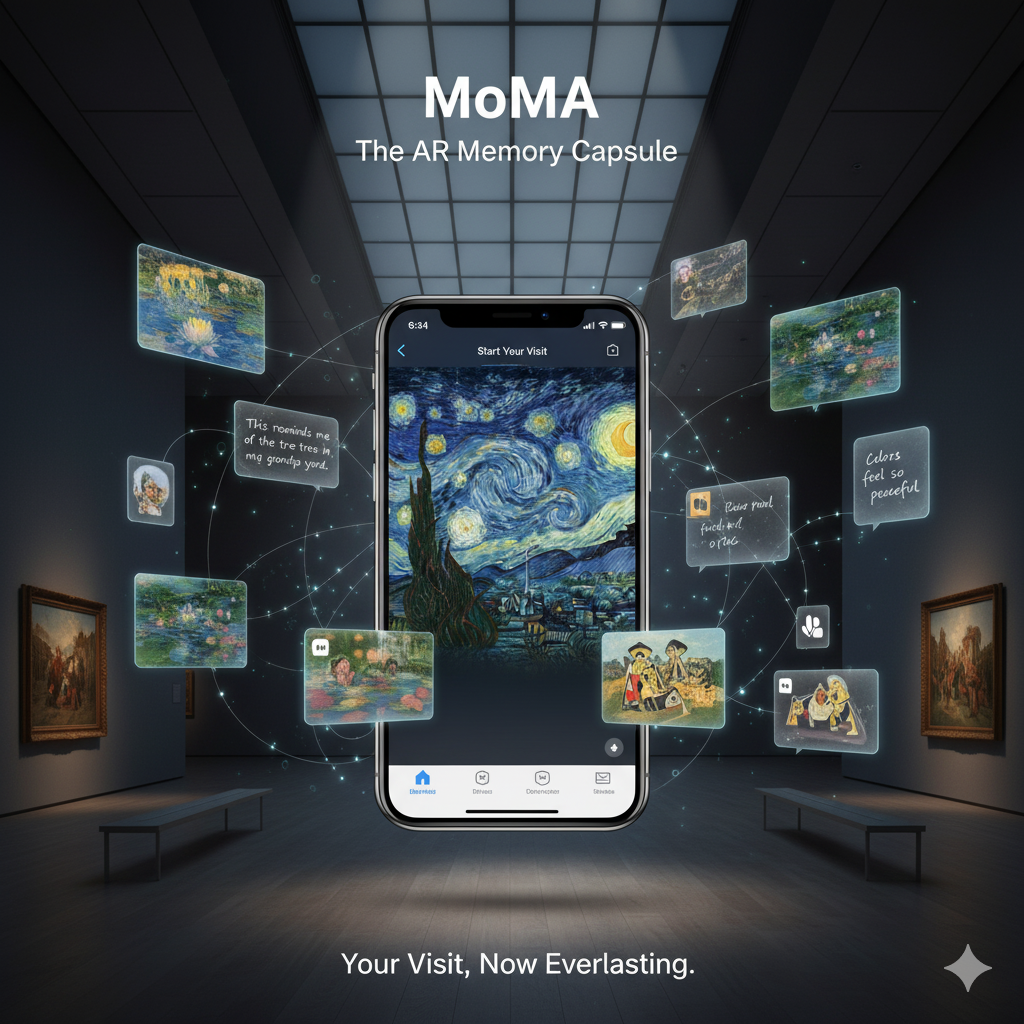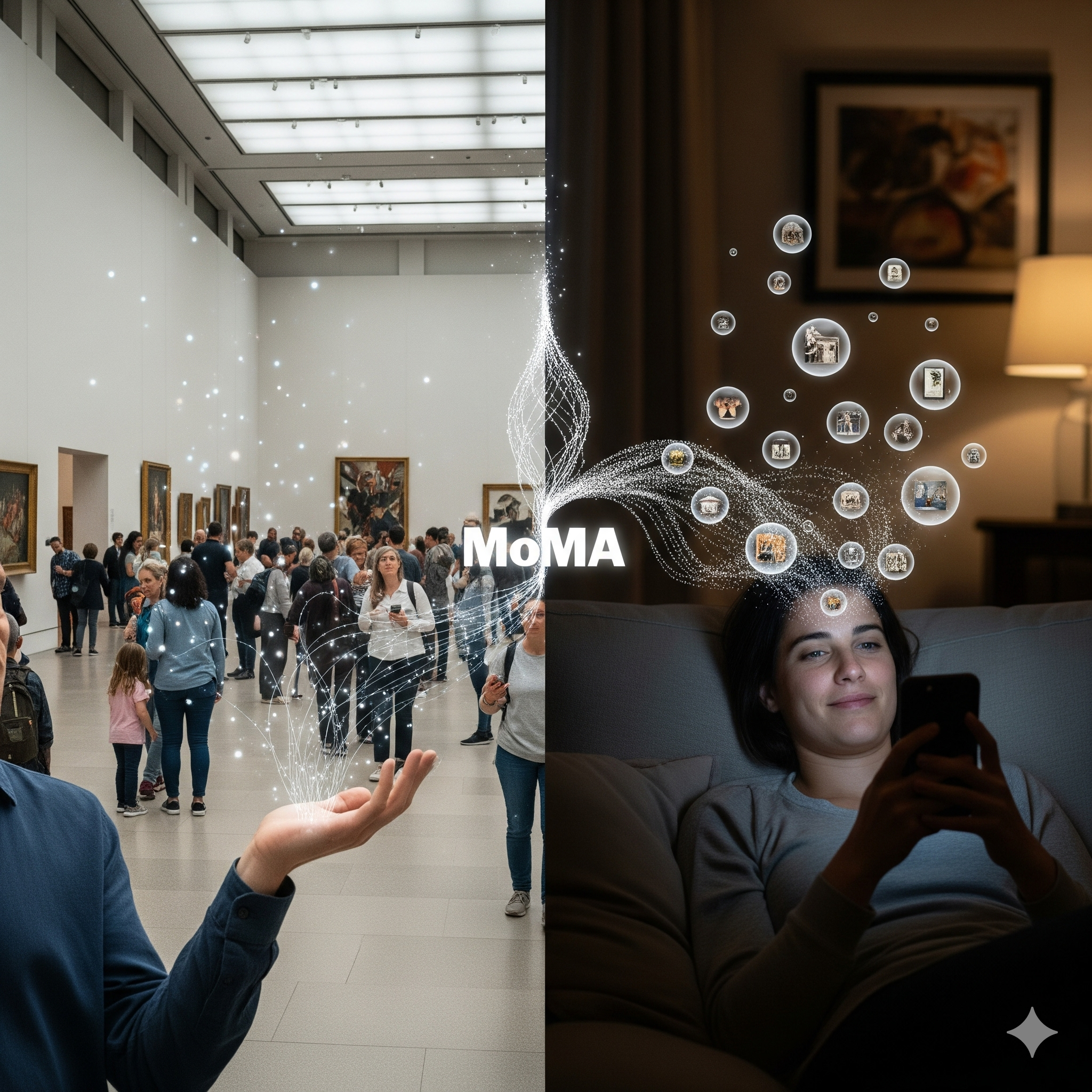MoMA: The AR Memory Capsule
Concept Design – Mockup
When your emotion becomes art.
Do you remember the quiet thrill of standing before The Starry Night? The MoMA app transforms that fleeting moment into something you can hold onto — a memory that lives beyond your visit. Through Augmented Reality, your emotions become part of the artwork itself. Because art isn’t complete until your story joins it.
The Origin of the Project: Fleeting Emotions
I’ve always loved art and music — both the beauty of what’s created, and the emotions they awaken. Some of my clearest memories come from museums: seeing Liberty Leading the People at the Louvre — the painting that inspired Les Misérables, a musical I adore — and The Starry Night at the MoMA in New York.
When I lived in New York, I often wandered through the MoMA. Each visit deepened my appreciation, yet something always felt incomplete. I wrote down my impressions in journals, but those notes couldn’t capture how I felt in that exact moment — the sound of the crowd, the quiet awe, the emotion behind my breath. Days later, those feelings faded. Even when I looked back at photos or postcards, all I remembered was the fact that I’d seen the painting — not the way it had made me feel.
That realization hurt a little: every museum visit ended the moment I stepped outside. The emotions disappeared with the exit doors.
Art Is Complete When It Becomes a Personal Story
One of my favorite things in a museum is listening to others describe what they see. Someone might whisper, “This reminds me of my grandmother’s kitchen,” or “These colors feel like the summer I spent in Spain.”
That’s when art comes alive — when it becomes personal. It made me wonder: what if those fleeting, intimate stories could be preserved and shared? Not just as comments on a screen, but as living memories that others could feel and add to — creating a continuous dialogue between art and emotion.
From that thought came the AR Memory Capsule — a feature for the MoMA app that lets visitors record their impressions in real time, and revisit them long after leaving. It turns a one-time viewing into an ongoing story — where each person adds a new layer to the collective memory of art.
🎟 Museum Ticketing × AR Memory Capsule (MoMA)
Problem
Imagine standing before The Starry Night. You take a photo, maybe buy a postcard — but a few days later, the awe fades. You’re left with a simple memory: “I saw that in person.” For visitors, emotions are lost. For museums, opportunities are missed.
Studies show that 81% of museum visitors use smartphones during visits — to take photos, look up details, or share impressions. A Pew Research Center report also found that over one-third of museum-goers post about their experiences online. Clearly, people don’t just want to see art — they want to connect with it and share their personal interpretations. But current museum experiences end too soon.
Insight
An exhibition can be more than a viewing — it can be a personal record and a shared collective memory. If visitors could capture their emotions in the moment, they could revisit those feelings anytime — reliving the connection between art and self. And for the museum, these individual reflections can create valuable insights into what truly resonates with people.
Solution — The AR Memory Capsule
A digital layer that makes museum experiences unforgettable.
Step1. 🎫 Start the Visit
Scan your MoMA ticket’s QR code to activate the AR Memory Capsule. From that moment, the app quietly accompanies you through the galleries.
Step 2. 🖼 Automatic Capture
As you stand before a painting, the app recognizes the artwork and creates an AR snapshot of the moment — the light, your proximity, your presence.
Step 3. 🗣 Record Your Impressions
Right there, you can leave a short voice note or a written thought — capturing emotion before it slips away. Not just “This painting is beautiful,” but something deeply personal:
“This sculpture feels like the tree in my grandfather’s yard — peaceful and familiar.”
“The colors remind me of a sunset I once watched with someone I loved.”
Each note becomes part of your personal memory capsule — your private layer of meaning inside the museum.
Step 4. 🖼 Personal Virtual Gallery
After your visit, your impressions and AR snapshots appear in your Virtual Gallery. You can revisit them anytime, share them with friends, or reflect on how your feelings toward art evolve over time.
+📊 Feedback & Insights
The anonymized data is shared with artists and the museum to understand which works evoke the deepest emotions. It helps shape future exhibitions and creates a more human connection between the institution and its visitors — where both learn from each other.
+🌟 Year-End Event
At the end of each year, MoMA could host a special exhibit showcasing a curated collection of these anonymous reflections — a celebration of how art moved people that year. Selected participants receive invitations, turning individual emotions into a collective celebration of empathy and creativity.
Impact
For the Visitor
Museum visits no longer fade into memory — they grow richer over time. Each recorded impression becomes a seed of nostalgia and self-discovery, turning art into a deeply personal dialogue.
For the Museum
It transforms passive viewing into participatory storytelling. The museum gains insight into emotional engagement, guiding future curations and programs. According to the 2020 Arts & Economic Prosperity Report, visitor data like this directly contributes to stronger engagement and repeat visits.
For the Brand
MoMA becomes more than a museum. It becomes a living archive of human emotion — a space where art and memory coexist. A place where each visitor’s voice quietly joins the chorus of shared experience.
—
Speculative UX Concept by Jin Kim
Visual mockups generated with Gemini & ChatGPT (for concept purposes only)




